K900 Gives Kia a Luxury ‘Multi-Vitamin’
By John Gilbert
To the uninformed, K900 might sound like the latest super-vitamin, capable of doing mighty things for your well-being and overall health. In a way, it is that for Kia, because the K900 is Kia’s all-out luxury sedan, powering Kia to rise to a new dimension in automotives.
Skeptics might say that Kia has become known for building strong and inexpensive economy cars, so what are they thinking building a large sedan to compete in the all-out luxury car segment? “We didn’t build the K900 just to serve the market,” said Orth Hedrick, Kia’s vice president of product planning. “This car is designed to change the perception of Kia.
“We had four points we focused on — design, luxury, performance, and technology. In design, we think we hve a modern, timeless look that has a presence.
“For luxury, we have an elegant version of the signature grille and 16-element LED headlights on the outside, and a new definition of what a luxury interior has to be, with modern, sophisticated materials and every touch point making you think luxury and sophistication. It took us three or four years to find a source for the Nappa leather hides from South America that were exactly what we wanted, and the natural wood accents complement it.
“Performance comes from the platform with a stance that can only be gotten by rear-wheel drive,” Hedrick added. “We’ve got 52 percent of the weight on the front and 48 percent on the rear, with a solid structure.”
Of course, the 5.0 V8 is a key element of the performance, with 429 horsepower and 376 foot-pounds of torque, running through an 8-speed automatic that Kia has tweaked for quicker shifting, up and down.
Technology is evident throughout the exterior styling and mechanical features, but blends with luxury that surrounds occupants on the inside. Seats are encompassing in their support and comfort. The multimedia driver assist has a 9.2-inch screen in the center stack, with adjustable redundant readouts on a heads-up display. The optional Harmon Kardon Lexicon audio system has a 12-channel digital amplifier and 17 speakers. Adaptive lane-finding is a feature on the headlights, which have a unique arrangement with two 4-LED clusters on each side, making 16 separate beams.
Kia faces an interesting challenge in the automotive landscape. As either a partner or subsidiary of powerful Hyundai in Seoul, South Korea, Kia has enjoyed a rejuvenation over the last decade, but still must find ways to prove that its new models are more than rebadged and restyled versions of Hyundai models.
Hyundai has its subcompact Accent, sporty Veloster, compact Elantra, midsize Sonata, full-size Azera, entry-luxury Genesis, and top-of-the-line luxury Equus, plus a coupe at the Genesis level, and a couple of impressive crossover SUVs in the Tucson and Santa Fe. Kia has dutifully matched up pretty well, with flashy design and sportier handling in some cases with the subcompact Rio, compactd Forte, and midsize Optima, plus the SUV partners Sportage and Sorento.
Kia moved up to the entry-luxury level for 2014 with the impressive and well-received Cadenza, which is built on the Azera’s front-wheel-drive platform. Luxury-bolstered models of the Optima and Cadenza reinforced Kia’s idea that its customers could be enticed to look at a full luxury sedan.
That’s where the K900 rises to the occasion. Unlike every other Kia built, the K900 is on a platform featuring front-engine/rear-drive.
When I first heard about the K900, coming on the tailpipes of the Credenza, I assumed it was built on the rear-drive platform of the Genesis. It is not. It is built on the longer, larger platform used by the Equus. But there are significant differences.
“It’s built on a 119.9-inch wheelbase,” said Kia product planner Eddie Rayyan, stressing that it shares wheelbase with the Equus, but the longer K900 tapers to more of a sporty-luxury look. “It has either the 5.0-liter direct-injection V8, or a 3.8-liter direct-injection V6.”
The rear-wheel drive configuration is what traditional high-performance zealots advocate, recalling the exhilaration when going into a tight turn on a road or raceway a little too hot and hanging out the rear end from the sheer application of power to the rears. Corvettes, Camaros, Mustangs, other sports cars, and on down to the most legendary models from BMW and Mercedes share the rear-drive kick. Of course, those who drive where foul-weather involves ice and snow for solid portions of each year realize that in this modern era, front-wheel drive and all-wheel drive makes a lot more sense. Even BMW and Mercedes now offer AWD on most of its models. That leads to the suspicion that all-wheel drive might be in the future for the K900.
The V6 will be coming along after introduction. At the press intro of the K900, which was held at Newport Coast, California, at an elaborate resort hotel named Pelican Hill. Luxurious and accommodating as it was, it made the perfect launch pad for the K900 — especially on a couple days in February where the temperature in Northern Minnesota ranged from 20-35 degrees BELOW zero.
“We tested the K900 running in the heat of Death Valley, and the cold in Northern Minnesota,” Rayyan said. “And when we decided to build this car, we benchmarked the best in the industry, like the BMW 7 Series, the Audi A8, Lexus LS, and Mercedes S Class, and we think we match up very well. We aimed at an $84,000 BMW 740 and we’re selling our comparably equipped K900 at $65,500 , and we have 105 more horsepower.”
That is the secret to Kia’s plan. With two models, the V6 K900 will start at $50,000, and the loaded V8 model at $65,500. Either way, the K900 price will include a 3-year maintenance contract, along with the traditional 10-year/100,000-mile basic warranty.
“We have a 5-link, fully independent front and rear suspensions, made of aluminum, and we have different circumference wheels front and rear,” said Hedrick, a vast departure with firmer handling than the air-suspension in the Equus. “The K900 structure contains 75 percent high-strength or ultra-high-strength steel. We have a lot of metallurgists at work on this.”
The K900 may share the platform and wheelbase of the Equus, but it is 2.5 inches longer, resulting in that sleek, tapering overhang, and the 5-link, coil-over suspension makes a more engaging drive. Pushing the Equus 5.0 V8 hard, through some twisting mountains east of Newport Coast allowed us to enjoy paddle-shifting control of the slick-shifting 8-speed automatic, and the big sedan defied being stuffed into the feeling and image of the typical heavyweight luxury cruiser.
Eight airbags and all the high-tech vehicle-warning systems prevail, alerting the driver to anything driving close to the K900, and warnings of objects ahead alert the driver through warning lights, sounds, vibrating seat harnesses, and the more important capabilities such as automatically preloading the brakes when the car realizes a potential collision is imminent.
Kia wanted more than that from the K900, and after some hard preliminary driving, it appears to have it. And I didn’t even get a chance to climb into the rear seats, where the spacious cabin features reclining bucket seats. If it seems the K900 has about everything anyone could want in a luxury car — especially a bargain luxury car — maybe that analogy of a high-potency multi-vitamin isn’t so far-fetched after all.


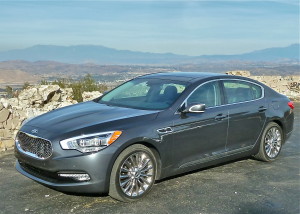
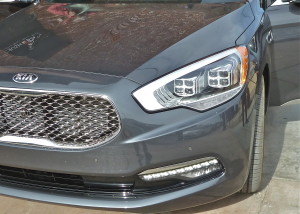
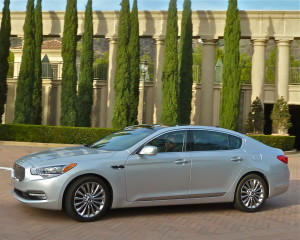
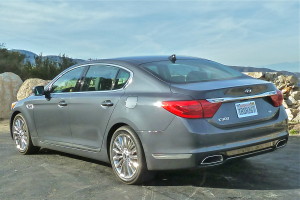
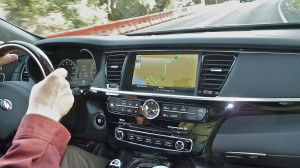
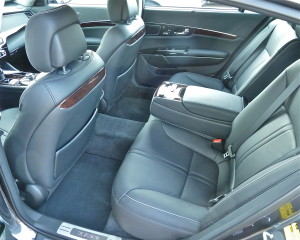
 John Gilbert is a lifetime Minnesotan and career journalist, specializing in cars and sports during and since spending 30 years at the Minneapolis Tribune, now the Star Tribune. More recently, he has continued translating the high-tech world of autos and sharing his passionate insights as a freelance writer/photographer/broadcaster. A member of the prestigious North American Car and Truck of the Year jury since 1993. John can be heard Monday-Friday from 9-11am on 610 KDAL(www.kdal610.com) on the "John Gilbert Show," and writes a column in the Duluth Reader.
John Gilbert is a lifetime Minnesotan and career journalist, specializing in cars and sports during and since spending 30 years at the Minneapolis Tribune, now the Star Tribune. More recently, he has continued translating the high-tech world of autos and sharing his passionate insights as a freelance writer/photographer/broadcaster. A member of the prestigious North American Car and Truck of the Year jury since 1993. John can be heard Monday-Friday from 9-11am on 610 KDAL(www.kdal610.com) on the "John Gilbert Show," and writes a column in the Duluth Reader.